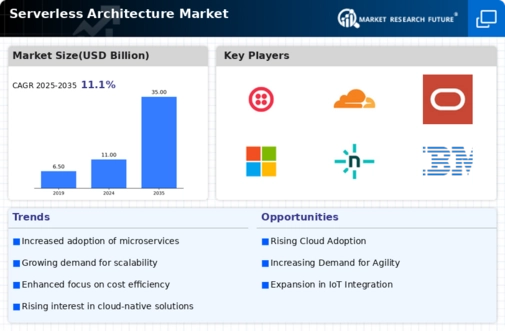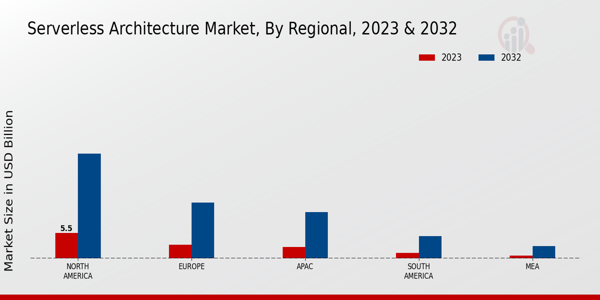Market Growth Chart
Enhanced Developer Productivity
The Global Serverless Architecture Market Industry is significantly influenced by the need for enhanced developer productivity. Serverless computing abstracts the underlying infrastructure, allowing developers to focus on writing code rather than managing servers. This shift can lead to faster deployment times and improved innovation cycles, as teams can iterate more rapidly. Companies adopting serverless architectures often report increased efficiency in their development processes. As organizations strive to remain competitive, the emphasis on productivity is likely to drive further investment in serverless solutions, contributing to a projected CAGR of 11.1% from 2025 to 2035.
Increased Demand for Scalability
The Global Serverless Architecture Market Industry experiences heightened demand for scalable solutions as organizations seek to accommodate fluctuating workloads. Serverless architecture allows businesses to automatically scale resources based on real-time needs, eliminating the need for manual intervention. This adaptability is particularly beneficial for startups and enterprises alike, as it enables them to optimize costs while maintaining performance. With the market projected to reach 11 USD Billion in 2024, the emphasis on scalability is likely to drive further adoption of serverless solutions across various sectors, including finance, healthcare, and e-commerce.
Cost Efficiency and Resource Optimization
Cost efficiency remains a pivotal driver in the Global Serverless Architecture Market Industry. By leveraging serverless computing, organizations can minimize infrastructure costs, as they only pay for the compute resources they utilize. This pay-as-you-go model is particularly appealing to small and medium-sized enterprises that may lack the capital for extensive infrastructure investments. As the market evolves, it is anticipated that the cost savings associated with serverless solutions will contribute to its growth, with projections indicating a market size of 35 USD Billion by 2035. This financial incentive encourages businesses to transition to serverless architectures.
Increased Focus on Digital Transformation
Digital transformation initiatives are a significant catalyst for growth in the Global Serverless Architecture Market Industry. As organizations increasingly prioritize digital solutions to enhance customer experiences and streamline operations, serverless architecture emerges as a viable option. It enables rapid development and deployment of applications, aligning with the fast-paced nature of digital transformation efforts. The ongoing shift towards cloud-based solutions and the need for agility in business operations are likely to drive the adoption of serverless architectures. This trend is expected to contribute to the market's expansion, with a projected size of 11 USD Billion by 2024.
Growing Adoption of Microservices Architecture
The trend towards microservices architecture is a crucial driver in the Global Serverless Architecture Market Industry. Microservices enable organizations to develop applications as a collection of loosely coupled services, facilitating easier updates and scalability. Serverless architecture complements this approach by allowing individual microservices to scale independently based on demand. This synergy is particularly attractive to enterprises looking to modernize their application development processes. As more organizations adopt microservices, the demand for serverless solutions is expected to rise, further propelling the market's growth in the coming years.

























